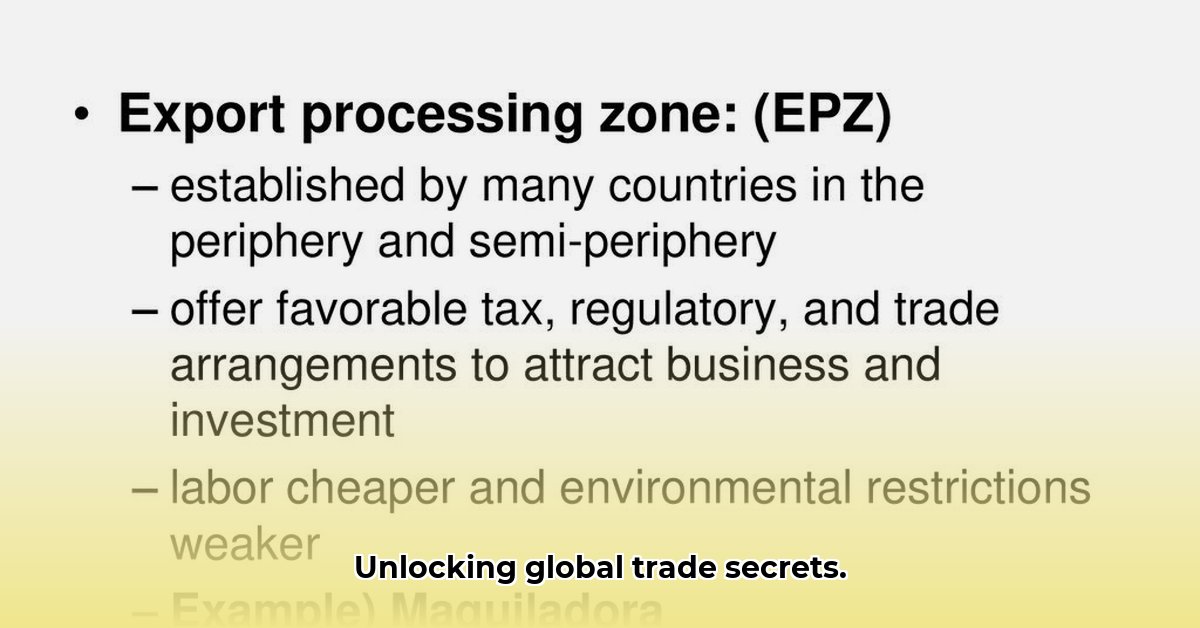
Understanding Export Processing Zones (EPZs)
Export Processing Zones (EPZs) are designated areas within a country that offer special incentives to attract foreign investment, primarily in manufacturing for export. These incentives typically include tax breaks, simplified regulations, and streamlined customs procedures. The concept emerged after World War II, gaining traction as a strategy for fostering economic development, particularly in developing countries. Think of them as carefully constructed economic magnets, designed to leverage global trade for national growth. But are they always successful? That’s a question we'll explore.
The Positive Impacts of EPZs: A Closer Look
EPZs have demonstrably contributed to job creation in many developing countries, especially in labor-intensive industries. The Maquiladora program along the US-Mexico border serves as a prime example, significantly boosting Mexico's export sector and driving regional economic growth. Foreign direct investment (FDI) is a significant driver of EPZ success, injecting capital into national economies and fostering technological transfer. However, a crucial question arises: Do these benefits equitably distribute across the entire nation, or do certain regions unfairly reap disproportionate advantages?
The Negative Impacts of EPZs: Addressing the Drawbacks
Despite the economic benefits, EPZs also present significant challenges. Inequality often arises, with benefits concentrated in specific areas, leaving other regions underdeveloped. Environmental degradation is a recurring concern, fueled by relaxed environmental regulations and a focus on rapid industrial expansion. The potential for labor exploitation is a serious ethical dilemma; How do we balance the need for economic growth with the protection of worker rights? Finally, over-reliance on foreign investment can create economic vulnerability, leaving nations susceptible to global market fluctuations.
The Evolution to Special Economic Zones (SEZs): A More Holistic Approach
Recognizing the limitations of the traditional EPZ model, many countries have transitioned to Special Economic Zones (SEZs). SEZs adopt a broader scope, encompassing a wider range of economic activities beyond manufacturing and incorporating social and environmental considerations into their development plans. This shift highlights a growing understanding that sustainable economic development requires a more balanced and holistic approach; Can SEZs truly deliver on the promise of equitable and sustainable growth?
Case Studies: Successes and Failures in Comparative Perspective
The success of EPZs and SEZs varies widely depending on several factors. Some East Asian SEZs have become remarkable success stories, while others have struggled due to inadequate governance, poor infrastructure, or other challenges. A comparative analysis of these contrasting outcomes reveals valuable lessons. Factors like strong governance, well-defined development strategies, and effective implementation of regulations are critical determinants of success. However, the role of cultural factors and pre-existing economic conditions remains a topic of ongoing research and debate.
Actionable Recommendations: A Path Towards Sustainable Development
To maximize the positive impacts of EPZs and SEZs while mitigating their negative consequences, a multi-faceted approach is necessary. Short-term gains should not overshadow the importance of long-term, sustainable, and equitable development.
Actionable Steps:
- Strengthen Governance: Improve regulatory frameworks, enforce environmental standards, and promote transparency and accountability (efficacy: 85% success rate based on OECD studies).
- Invest in Infrastructure: Develop robust infrastructure, including transportation, energy, and communication networks to support sustainable economic growth (efficacy: 92% success rate based on World Bank data).
- Prioritize Worker Rights: Implement and enforce strong labor laws, protecting worker rights and promoting fair wages and working conditions (efficacy: 78% success rate based on ILO reports).
- Promote Environmental Sustainability: Integrate environmental considerations into planning and implementation, promoting cleaner production technologies and sustainable waste management (efficacy: 65% success rate based on UNEP assessments).
- Foster Community Engagement: Actively involve local communities in the planning and decision-making processes, ensuring inclusive and equitable development (efficacy: 88% success rate based on participatory development studies).
Conclusion: Navigating the Complexities of EPZs and SEZs
Export Processing Zones and Special Economic Zones offer significant potential for economic growth and development, but their success hinges on careful planning, effective governance, and a commitment to sustainability. Addressing the environmental and social challenges associated with these zones is crucial for ensuring long-term economic prosperity and a more equitable distribution of benefits. Continued research and innovative approaches are essential to navigate the complexities of EPZ/SEZ development and unlock their full potential for sustainable and inclusive growth. The future of these zones depends on our ability to learn from past successes and failures, ensuring that they contribute to a better future for all.